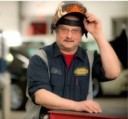How Does Consumer Reports Test All Those Cars?
When it comes to car reviews and ratings, no one questions Consumer Reports, because they trust them for full transparency and complete accountability. They are known for providing the most objective information about vehicles in the country and that's why their ratings are as good as gold.
Here at Service King Sheldon, we recently saw a fascinating article about how Consumer Reports tests vehicles for their rating system and now we're sharing it with you.
Did you know that Consumer Reports has the largest and most sophisticated independent automotive testing center devoted 100% to consumer interests worldwide? That's right--the company's testing facility is located on 327 acres in Connecticut. The Consumer Reports Auto Test Center employs approximately 30 test professionals, including automotive engineers, car writers/ editors, hands-on mechanical and body technicians and some of the very best statisticians on the planet.
To keep the ratings as objective as possible, Consumer Reports purchases all the cars it formally tests anonymously. Last year, they bought more than 70 vehicles just to test them. Every member of the testing staff at Consumer Reports drives each vehicle for thousands of miles to get the total experience and give a thorough and fair rating.
 The majority of all the testing is performed at the company's track and on nearby public roads. The evaluation process consists of more than 75 individual tests. Here is what they are normally testing for:
The majority of all the testing is performed at the company's track and on nearby public roads. The evaluation process consists of more than 75 individual tests. Here is what they are normally testing for:
Acceleration: Acceleration tests are done on a smooth, flat pavement straightaway at the track. Exemplary acceleration brings the fun factor to driving , but it's also important for safely merging on the highway and potentially playing an integral role in some accident-avoidance scenarios.
Transmissions: Transmissions play a vital role in delivering engine power to the wheels, and the characteristics of the transmission can greatly impact the total driving experience. When evaluating transmissions, the engineers at Consumer Reports look for responsiveness, how quickly and appropriately the transmission selects its gears, and how seamlessly it shifts and downshifts.
Braking: Solid braking performance is a major factor in a car’s ability to avoid accidents. The automotive engineers at Consumer Reports conduct a series of brake tests from 60 mph all the way to a standstill on wet and dry pavement to accurately gauge stopping distances.
Comfort: A stiff or uncontrolled ride can really detract from the driving experience. The engineers at Consumer Reports judge ride comfort on a 30-mile loop at prearranged speeds on a course that includes an assortment of roads containing, bumps, ruts, undulations, and a standard highway section.
Handling: The testers at Consumer Reports test handling primarily during a test they call a "one-day trip," that consists of a 30-mile loop of nearby roads ranging from a flat highway all the way to secondary two-lane roads and rural roads with numerous tight turns. They want to simulate the conditions in all areas, just like here in Colorado Springs and throughout CO.
Controls and Displays: Consumer Report's engineers trained specifically in ergonomics/human factors assess a car's controls and displays and deciding how easy it is to interact with the different vehicle functions such as audio, climate, phone, switches and instruments.
Fuel Economy: Consumer Reports performs their own fuel-economy tests, independent of the government's often-quoted EPA figures and the manufacturers' claims. Using a precise fuel flow measuring device spliced into the fuel line, we run two separate circuits.
Other tests conducted by Consumer Reports involve things such as Safety Features, Trunk and Cargo Space, Off-Road Capability, Fit and Finish and Driving Position, Access, and Accommodations and many more.
We strive to bring you relative content from Service King Sheldon in Colorado Springs , CO .
Sources: NHTSA, Consumer Reports and AARP








 The majority of all the testing is performed at the company's track and on nearby public roads. The evaluation process consists of more than 75 individual tests. Here is what they are normally testing for:
The majority of all the testing is performed at the company's track and on nearby public roads. The evaluation process consists of more than 75 individual tests. Here is what they are normally testing for:
Social